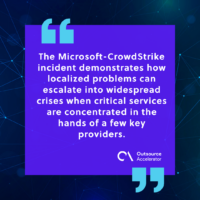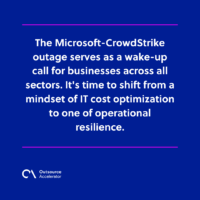Lessons from the Microsoft-CrowdStrike outage
The recent global IT meltdown caused by a faulty CrowdStrike software update for Microsoft devices shook industries worldwide.
Flights were grounded, healthcare services were interrupted, and businesses plunged into chaos.
As we start picking up the pieces from what some are dubbing the “largest IT outage in history,” businesses of all sizes should reassess their IT strategies and outsourcing practices to avoid similar fiascos in the future.
When IT dependencies crumble
The ripple effects from a single software update failure highlight just how fragile our interconnected systems are. Airlines canceled thousands of flights, hospitals had to use pen and paper, and businesses were paralyzed as essential systems crashed.
This wasn’t just a minor technical hiccup—it was a stark reminder of how deeply IT services are embedded in modern business operations.
For many organizations, the incident uncovered an uncomfortable truth: their operations rely heavily on systems and services beyond their control. While outsourcing IT functions can be beneficial for expertise and cost efficiency, it also introduces vulnerabilities that need careful management.
The Microsoft-CrowdStrike incident demonstrates how localized problems can escalate into widespread crises when critical services are concentrated in the hands of a few key providers.
Rethinking IT strategy for resilience
Businesses need to take a proactive approach to their IT infrastructure and outsourcing relationships.
This doesn’t mean abandoning outsourcing altogether, but rather implementing a more nuanced, risk-aware approach. Consider these strategies:
- Diversify your technology stack: Avoid over-reliance on a single vendor by working with multiple providers for critical services.
- Maintain in-house expertise: While outsourcing is efficient, keeping core IT competencies in-house ensures a quick response to crises.
- Implement rigorous testing protocols: Insist on thorough testing of all updates and patches, even from trusted vendors, before they’re applied to your systems.
- Develop robust contingency plans: Prepare for worst-case scenarios with clear procedures for manual operations and system recovery.
By adopting these principles, businesses can create a more resilient IT ecosystem that balances the benefits of outsourcing with the need to mitigate risks.
Building a more resilient business
The Microsoft-CrowdStrike outage serves as a wake-up call for businesses across all sectors. It’s time to shift from a mindset of IT cost optimization to one of operational resilience. This means:
- Regularly assessing IT vendors: Continuously monitor the performance and reliability of all IT partners.
- Investing in redundancy: Redundancy for critical systems and services is crucial, even if it means higher short-term costs.
- Promoting cybersecurity awareness: Develop a culture of cybersecurity awareness throughout the organization, not just within the IT department.
- Updating business continuity plans: Ensure they remain effective in an ever-changing technological landscape.
By embracing these principles, businesses can build a more robust IT infrastructure that delivers efficiency and expertise while mitigating the risks of our interconnected world.
As we reflect on the lessons of this unprecedented outage, let’s seize the opportunity to reshape our approach to IT management and outsourcing. Your business’s continued success and resilience in the face of future challenges depend on the actions you take today.
The question for your business…
Are you prepared for the next crisis?



 Independent
Independent





















